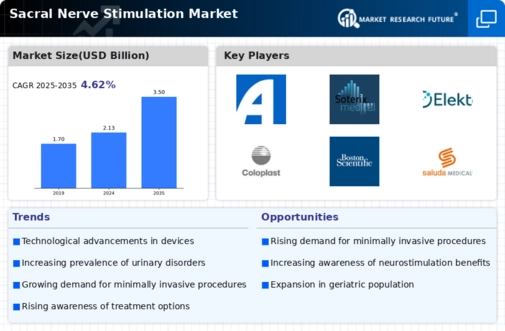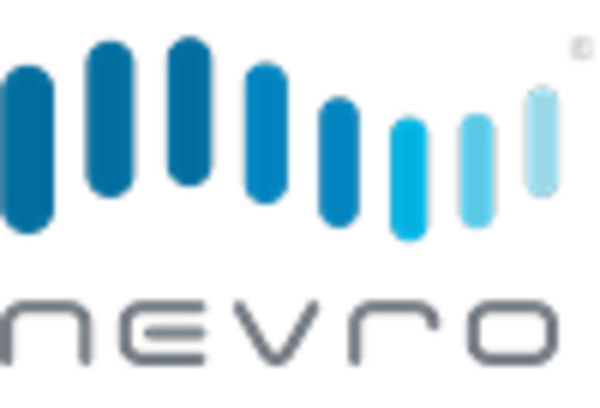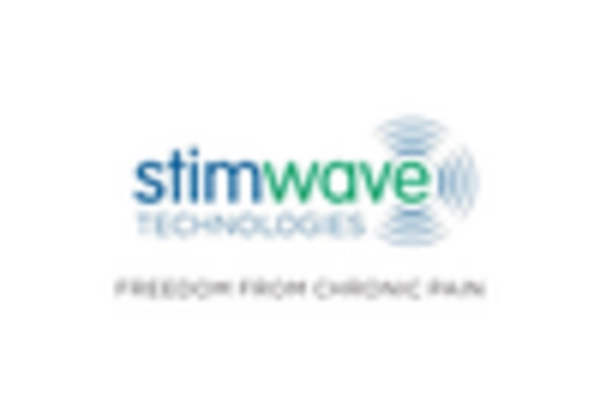Increasing Healthcare Expenditure
The rise in healthcare expenditure across various regions is a significant driver for the Sacral Nerve Stimulation Market. As governments and private sectors allocate more funds towards healthcare, there is a corresponding increase in the availability of advanced medical treatments, including sacral nerve stimulation. This trend is particularly evident in developed economies, where healthcare budgets are expanding to accommodate innovative therapies. According to recent reports, healthcare spending in the United States is projected to reach nearly 20% of GDP by 2028, indicating a robust investment in medical technologies. This increase in funding not only facilitates the adoption of sacral nerve stimulation devices but also encourages research into new applications and improved treatment protocols. As a result, the growing healthcare expenditure is likely to bolster the market for sacral nerve stimulation devices.
Technological Innovations in Device Design
Technological advancements in the design and functionality of sacral nerve stimulation devices are significantly influencing the Sacral Nerve Stimulation Market. Recent innovations have led to the development of more compact, efficient, and user-friendly devices that enhance patient comfort and treatment efficacy. For instance, the introduction of rechargeable batteries and wireless technology has improved the usability of these devices, making them more appealing to both patients and healthcare providers. Market data suggests that The Sacral Nerve Stimulation is projected to grow at a compound annual growth rate (CAGR) of approximately 8% over the next few years, driven by these technological improvements. As manufacturers continue to invest in research and development, the introduction of next-generation devices is expected to further stimulate market growth, offering enhanced therapeutic options for patients.
Growing Awareness and Education Initiatives
The rise in awareness and education initiatives regarding bladder disorders and their treatment options is a crucial driver for the Sacral Nerve Stimulation Market. Healthcare organizations and advocacy groups are actively promoting information about conditions such as urinary incontinence and the benefits of sacral nerve stimulation. This increased awareness is leading to more patients seeking treatment, thereby expanding the market. Data suggests that educational campaigns have resulted in a notable increase in consultations for sacral nerve stimulation, as patients become more informed about their options. Furthermore, as healthcare providers emphasize the importance of early intervention, the demand for sacral nerve stimulation devices is likely to grow. Consequently, the ongoing efforts to educate both patients and healthcare professionals are expected to play a pivotal role in driving the market forward.
Rising Prevalence of Neurological Disorders
The increasing incidence of neurological disorders, particularly those affecting bladder control, is a primary driver for the Sacral Nerve Stimulation Market. Conditions such as overactive bladder and urinary incontinence are becoming more prevalent, with studies indicating that nearly 33 million individuals in the United States alone suffer from overactive bladder. This growing patient population necessitates effective treatment options, thereby propelling the demand for sacral nerve stimulation devices. As healthcare providers seek innovative solutions to manage these conditions, the market for sacral nerve stimulation is expected to expand significantly. Furthermore, the aging population, which is more susceptible to such disorders, adds to the urgency for advanced therapeutic interventions. Consequently, the rising prevalence of these disorders is likely to sustain the growth trajectory of the Sacral Nerve Stimulation Market.
Rising Demand for Minimally Invasive Procedures
The growing preference for minimally invasive procedures among patients and healthcare providers is a notable driver for the Sacral Nerve Stimulation Market. Patients increasingly seek treatment options that offer reduced recovery times, lower risks of complications, and minimal discomfort. Sacral nerve stimulation, being a minimally invasive technique, aligns well with these patient preferences. Market analysis indicates that minimally invasive procedures are gaining traction, with a projected increase in their adoption rate. This shift is further supported by healthcare professionals who recognize the benefits of such techniques in enhancing patient outcomes. As the demand for less invasive treatment options continues to rise, the sacral nerve stimulation market is expected to experience substantial growth, driven by the increasing acceptance of these innovative procedures.


















Leave a Comment